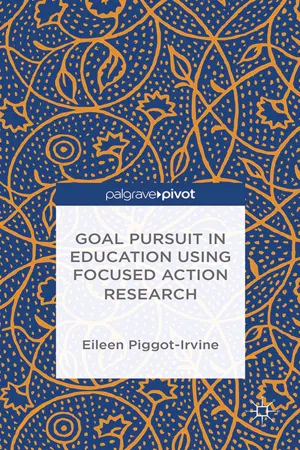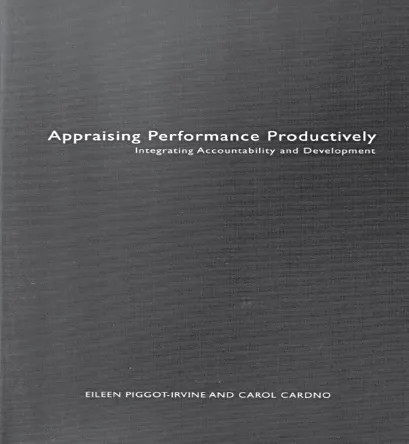
This is a test
- English
- ePUB (mobile friendly)
- Available on iOS & Android
eBook - ePub
Goal Pursuit in Education Using Focused Action Research
Book details
Book preview
Table of contents
Citations
About This Book
Not everyone finds goals easy to select or focus on, despite escalating evidence of their importance in education. This book offers a simple action research approach to goal pursuit, favoring depth, informed decision making, and an improvement orientation. It presents practical, yet academically informed, ideas, and has real case study examples.
Frequently asked questions
At the moment all of our mobile-responsive ePub books are available to download via the app. Most of our PDFs are also available to download and we're working on making the final remaining ones downloadable now. Learn more here.
Both plans give you full access to the library and all of Perlego’s features. The only differences are the price and subscription period: With the annual plan you’ll save around 30% compared to 12 months on the monthly plan.
We are an online textbook subscription service, where you can get access to an entire online library for less than the price of a single book per month. With over 1 million books across 1000+ topics, we’ve got you covered! Learn more here.
Look out for the read-aloud symbol on your next book to see if you can listen to it. The read-aloud tool reads text aloud for you, highlighting the text as it is being read. You can pause it, speed it up and slow it down. Learn more here.
Yes, you can access Goal Pursuit in Education Using Focused Action Research by Eileen Piggot-Irvine in PDF and/or ePUB format, as well as other popular books in Education & Educational Policy. We have over one million books available in our catalogue for you to explore.
Information
Topic
EducationSubtopic
Educational Policy1
Introduction to How a Reluctant Goal Pursuer Became Converted
Abstract: Chapter 1 backgrounds my interest and rationale for goal pursuit: an interest that was far from enthusiastic at the beginning of my career. The importance of goal pursuit for strategic planning, development, learning, and performance review is discussed. A particular focus is placed on how alignment of goals in strategic planning and performance review can enhance performance. This chapter also outlines how I have translated my interest in action research (AR) to the Focused Action Research (FAR) Model for goal pursuit. Brief details of this simple model and associated phased activity are introduced; the rest of the book elaborates this activity. The FAR Model encourages evidence-based phases of Preparation, Reconnaissance, Implementation, Evaluation, Recommendation drawing, and Reporting in goal pursuit. It is underpinned by the three key principles of shift in depth, lift in challenge, and authentic collaboration.
Keywords: action research; authentic collaboration; challenge; depth; FAR Model; goal alignment; performance review
Piggot-Irvine, Eileen. Goal Pursuit in Education Using Focused Action Research. New York: Palgrave Macmillan, 2015. DOI: 10.1057/9781137505125.0006.
In my career as a teacher, leader, and coach to hundreds of leaders in almost every type of organization I have often heard people speaking disdainfully about focusing on goal pursuit (which I am defining as goal setting, achievement, and evaluation). I have listened to many people resisting the thought of being constrained by goals, rather favouring to enjoy being a free spirit and letting patterns, work, and life unfold in serendipitous ways. I confess I have a strong element of that in my own personality too, so I have some sympathy with the sentiment.

FIGURE 1.1 Eileen in a non-constrained mode
Early in my career, I clearly recall a neighbour, a professional woman, asking what my plans A, B, and C were for my career direction. I remember being dumbstruck. I felt deeply disturbed at the thought of being so tightly pinned down and in many ways I have not changed in that feeling. Although I am doggedly determined and focused (or many would say “stubborn”) in whatever I pursue, I have not favoured narrow, long-term planning. My career, for example, has unwrapped like one of those beautifully layered parcels with a precious surprise in the middle. If I had been following plan A, B, or C, I would never have reached that gem in the middle which I usually describe as my perfect role.
So, given this sentiment, you may well ask why on earth I would choose to write a book on goal pursuit! I think the answer to this lies in my cumulative experience rather than in my somewhat independent spirit. As a leader and coach (and mother), I have sometimes been painfully reminded that not everyone, including myself, finds it easy to either select or focus on goals through to full pursuit. It is within these roles, and to resolve my own reluctance to formalize pursuit of goals, that I have realized the need to create an approach to goal pursuit fitting my own inclinations. These inclinations, especially in my professional life, include favouring depth and evidence rather than superficiality and subjectivity, doing fewer things well, a fascination with action research (AR) and improvement oriented processes, and an emphasis on authentic collaboration.
Inclinations for depth and collaborative processes
The content of this book reflects my inclinations but it also results from a couple of decades of development. I started practising the approaches to goal pursuit outlined in this book in my first leadership role where I was tasked with creating an ‘appraisal’, performance review, system for an educational organization. I spent months struggling with reviewing the literature on effectiveness in this field in order to consolidate my thinking on how a system could be developmental yet meet organizational accountability needs. Despite my aversion to tight goal setting, I kept circling back to the necessity of strongly owned yet meaningful and explicit goals. I developed a system which centred on goals that were personally relevant and developmentally deep whilst strategically aligned at the organization level (Piggot-Irvine, 2003). I introduced this system with work teams I led with reasonable success, to the extent that others from outside the organization frequently asked me to facilitate sessions on the topic or help design their own approach.
The system I introduced led to the book Appraising Performance Productively (Piggot-Irvine & Cardno, 2005) for the education sector, which had a particular interest around the goal pursuit elements, and it sold like hotcakes. Subsequently, I have continued to strengthen my thinking about goal pursuit and appraisal/performance review and written more than ten articles associated with this topic, in addition to implementing presentations and workshops with hundreds of leaders within my consultancy and teaching practice. More and more frequently I have received requests to share my recent research, thinking, and tools with those who struggle either with goal pursuit for themselves or with guiding staff in this arena. This book outlines what I have developed and shared with others.

FIGURE 1.2 The front cover of Appraising Performance Productively
I have alluded to some inclinations and interests which have strongly influenced my approach to goal pursuit, and although each is elaborated further in later chapters, I just want to highlight a couple as an introduction. In the earliest stages of my career I was a biologist and you will see the objective biologist in me has never totally disappeared. It shows up in this book in my emphasis on encouraging evidence- or data-based decision making. I constantly search for verification for any viewpoint or assumption. Similarly, as a biologist, lately I have become fascinated with what we are learning about the brain’s response to stimuli. I have narrowed my interest in this ‘neuroscience’ field to searching for what is known about goal pursuit and brain response. I present a slightly cautious, ‘amber-light’, view on the way the more popularized neuroleadership field is presenting the results of this neuroscience research. However, the biologist in me could not resist including some of this material, because even though we know relatively little about how the brain works, many of the ideas drawn by the neuroleadership proponents actually fit very well with my own experience with goal pursuit.
A further interest, passion, that comes through strongly in the book is that of a 20-year obsession with an AR orientation in my approach to research and development (Piggot-Irvine, 2012; Piggot-Irvine & Bartlett, 2008; Piggot-Irvine, 2009; Piggot-Irvine, Connelly, Curry, Hanna, Moodie, Palmer, Peri, & Thompson, 2011). In this approach, as the name suggests, there is intent to move beyond just data collection to ensuring that change and improvement follows this data collection or research. In the AR approach I have adopted, an initial Preparatory focusing phase is followed by a ‘Reconnaissance’ or informed current situation ana...
Table of contents
- Cover
- Title
- 1 Introduction to How a Reluctant Goal Pursuer Became Converted
- 2 Why Should You Engage in Goal Pursuit?
- 3 A Simple, Yet Detailed, Model for Goal Pursuit
- 4 How the FAR Model Encourages Shift in Depth, Lift in Challenge, and Collaboration
- 5 What This Looks Like in a Real Case Study
- 6 Ten Useful Activities, Tools and Templates
- References
- Index